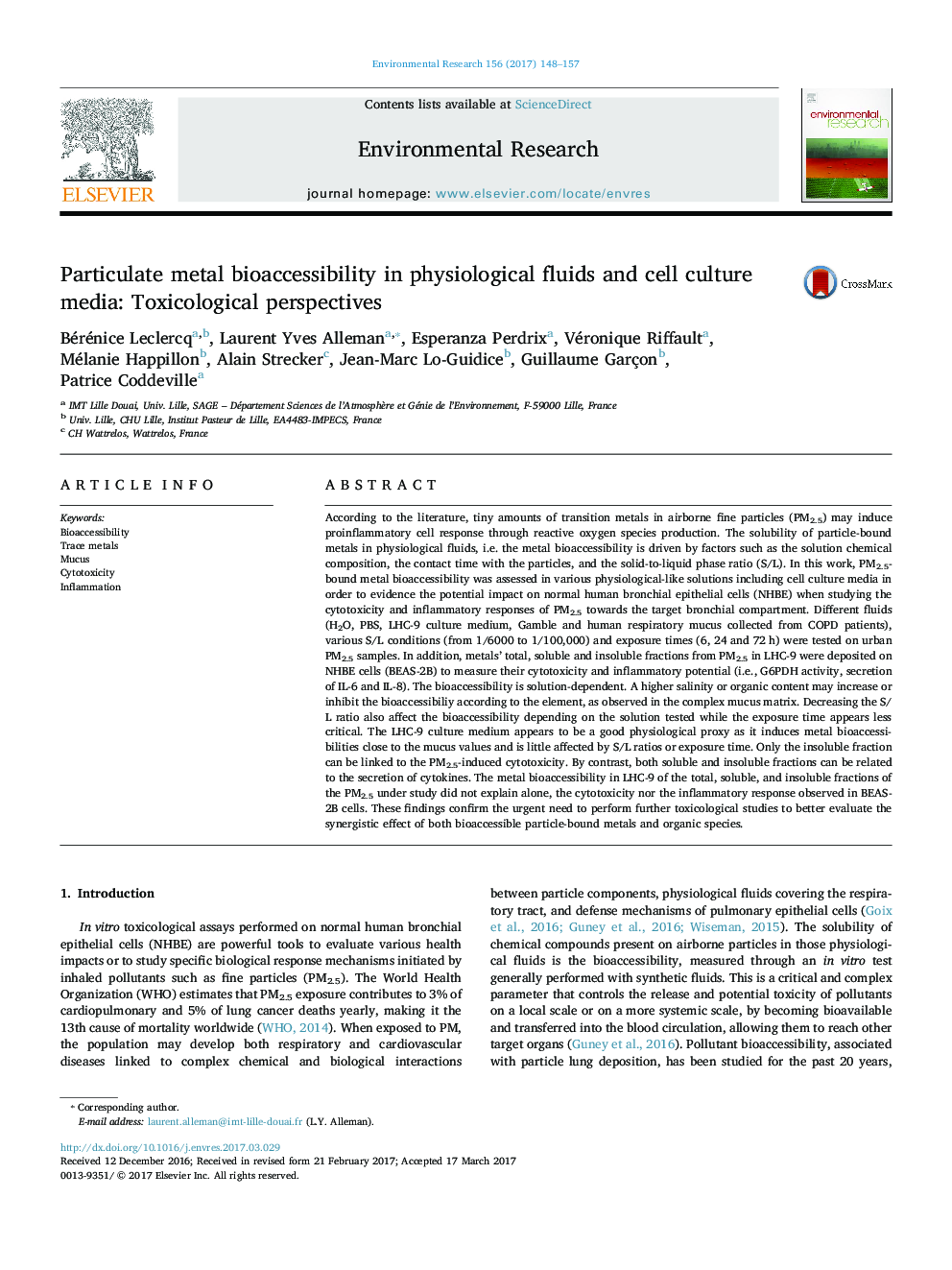| کد مقاله | کد نشریه | سال انتشار | مقاله انگلیسی | نسخه تمام متن |
|---|---|---|---|---|
| 5756518 | 1622547 | 2017 | 10 صفحه PDF | دانلود رایگان |
عنوان انگلیسی مقاله ISI
Particulate metal bioaccessibility in physiological fluids and cell culture media: Toxicological perspectives
ترجمه فارسی عنوان
دسترسی به فلزات جزئی در مایعات فیزیولوژیکی و رسانه های کشت سلولی: دیدگاه های سمی
دانلود مقاله + سفارش ترجمه
دانلود مقاله ISI انگلیسی
رایگان برای ایرانیان
کلمات کلیدی
دسترسی بیواسطه، فلزات کمیاب، موکوس، سمیت مسمومیت، التهاب
موضوعات مرتبط
علوم زیستی و بیوفناوری
علوم محیط زیست
بهداشت، سم شناسی و جهش زایی
چکیده انگلیسی
According to the literature, tiny amounts of transition metals in airborne fine particles (PM2.5) may induce proinflammatory cell response through reactive oxygen species production. The solubility of particle-bound metals in physiological fluids, i.e. the metal bioaccessibility is driven by factors such as the solution chemical composition, the contact time with the particles, and the solid-to-liquid phase ratio (S/L). In this work, PM2.5-bound metal bioaccessibility was assessed in various physiological-like solutions including cell culture media in order to evidence the potential impact on normal human bronchial epithelial cells (NHBE) when studying the cytotoxicity and inflammatory responses of PM2.5 towards the target bronchial compartment. Different fluids (H2O, PBS, LHC-9 culture medium, Gamble and human respiratory mucus collected from COPD patients), various S/L conditions (from 1/6000 to 1/100,000) and exposure times (6, 24 and 72Â h) were tested on urban PM2.5 samples. In addition, metals' total, soluble and insoluble fractions from PM2.5 in LHC-9 were deposited on NHBE cells (BEAS-2B) to measure their cytotoxicity and inflammatory potential (i.e., G6PDH activity, secretion of IL-6 and IL-8). The bioaccessibility is solution-dependent. A higher salinity or organic content may increase or inhibit the bioaccessibiliy according to the element, as observed in the complex mucus matrix. Decreasing the S/L ratio also affect the bioaccessibility depending on the solution tested while the exposure time appears less critical. The LHC-9 culture medium appears to be a good physiological proxy as it induces metal bioaccessibilities close to the mucus values and is little affected by S/L ratios or exposure time. Only the insoluble fraction can be linked to the PM2.5-induced cytotoxicity. By contrast, both soluble and insoluble fractions can be related to the secretion of cytokines. The metal bioaccessibility in LHC-9 of the total, soluble, and insoluble fractions of the PM2.5 under study did not explain alone, the cytotoxicity nor the inflammatory response observed in BEAS-2B cells. These findings confirm the urgent need to perform further toxicological studies to better evaluate the synergistic effect of both bioaccessible particle-bound metals and organic species.
ناشر
Database: Elsevier - ScienceDirect (ساینس دایرکت)
Journal: Environmental Research - Volume 156, July 2017, Pages 148-157
Journal: Environmental Research - Volume 156, July 2017, Pages 148-157
نویسندگان
Bérénice Leclercq, Laurent Yves Alleman, Esperanza Perdrix, Véronique Riffault, Mélanie Happillon, Alain Strecker, Jean-Marc Lo-Guidice, Guillaume Garçon, Patrice Coddeville,
